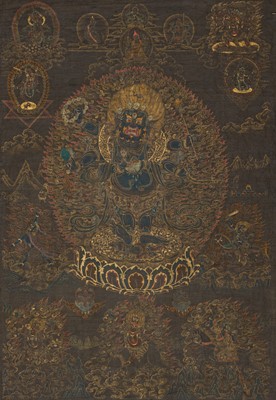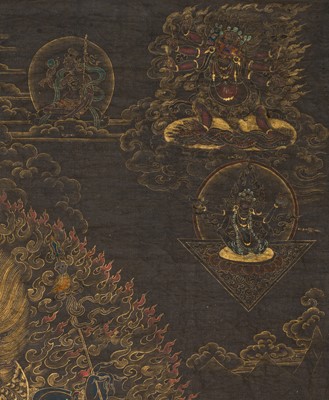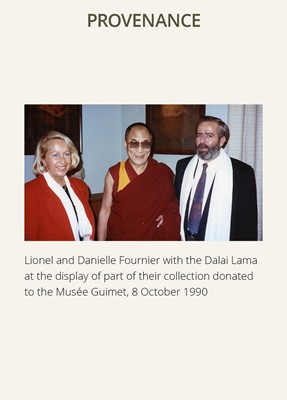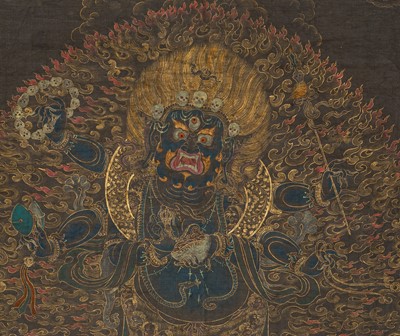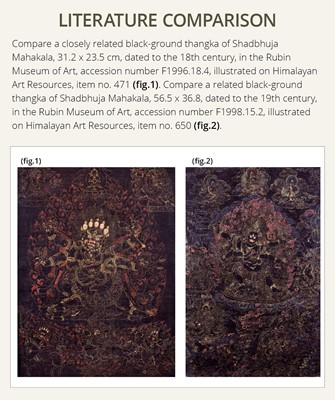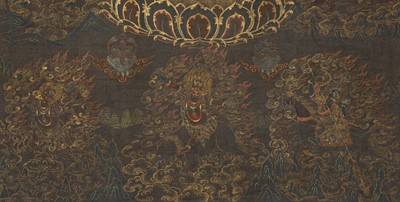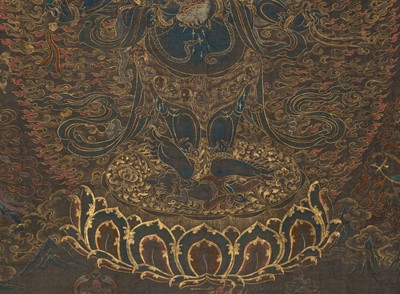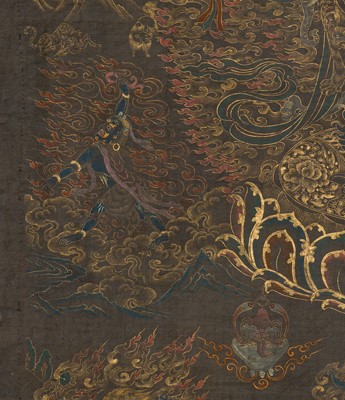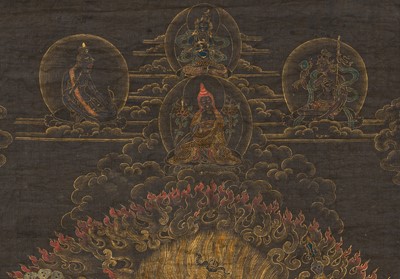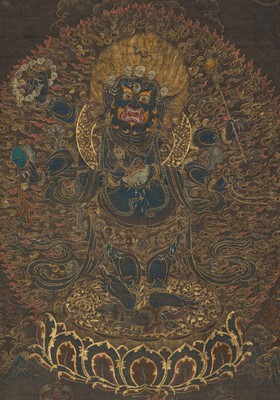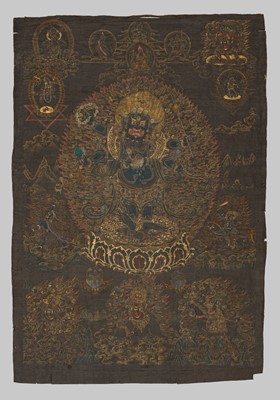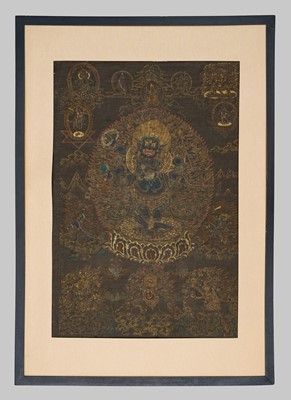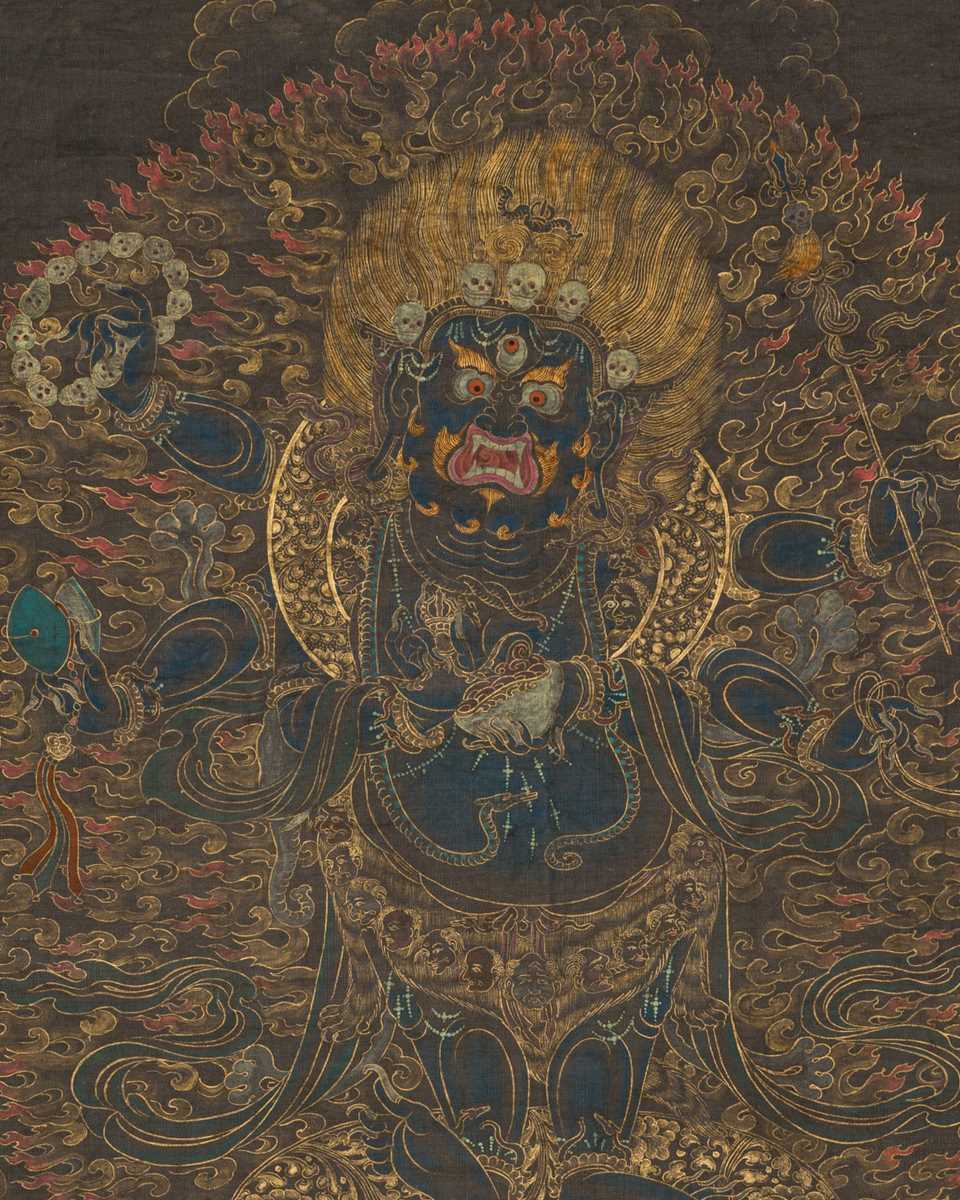11th Apr, 2024 11:00
TWO-DAY AUCTION: Fine Asian Art, Buddhism and Hinduism
28
A BLACK-GROUND THANGKA DEPICTING SHADBHUJA MAHAKALA, TIBET, 18TH CENTURY
Sold for €58,500
including Buyer's Premium
Published & Exhibited: Nathalie Bazin (ed.), Rituels tibétains: Visions secrètes du Ve Dalai Lama, Musée Guimet, Paris, 2002, cat. no. 53, page 111.
Distemper and gold on cloth. Encompassed by flickering flames he stands in samapada on ganapati placed on a lotus dais. His principal hands holding the ritual chopper and blood-filled skull. The other four with drum, rosary, staff and lasso. Khyung po rnal ‘byor depicted directly above with Naropa and his sister to his left and right, both flanking Vajradhara. Within the upper left corner Samvara in union with Vajrayogini above Chakrasamvara, and the right corner with Kechari above Hayagriva.
Provenance: The Private Collection of Lionel and Danielle Fournier, collected in Europe during the 1970s and 1980s. Christie’s Paris, 12 December 2018, lot 54, sold for EUR 62,500 or approx. EUR 71,000 (adjusted for inflation at the time of writing). A private collection in France, acquired from the above. Lionel Fournier (1943-2017) was an important collector and leading expert in Buddhist art from Tibet, Indian, and China, traveling extensively to Buddhist monasteries. He provided the photographs for Pratapaditya Pal’s “A Buddhist Paradise, The Murals of Alchi”, Western Himalayas, 1982. In the winter of 1990-1991, the Fourniers donated a part of their collection to the Musée Guimet, the donation titled “Art ésotérique de l’Himâlaya, la donation Lionel Fournier”, with a catalogue by Gilles Béguin. Both Lionel and Danielle Fournier received several awards for their generosity and work, culminating in their reception of the Knight of the Legion of Honor, the highest decoration to a civilian in France.
Condition: Very good condition with minor wear, light rubbing, and minimal creasing. The gold is particularly well preserved.
Dimensions: Image size 73.5 x 49.3 cm, Size incl. frame 98.8 x 69.9 cm
The lower register shows various protective deities. Many of these have identifying inscriptions written in gold, which have become illegible over time. The figures depicted are Kshetrapala riding his bear mount at the center next to two depictions of Trakshe riding his horse on the right with blue Takiraja and Shri Devi on the left.
The spiritual teacher directly above the central figure was identified by Amy Heller as Khyungpo Neljor, founder of the Shangpa Kagyu order, see Nathalie Bazin, ed., Rituels tibétains: Visions secrètes du Ve Dalai Lama, Paris, 2002, p. 110. Heller also identified Naropa (c. 956-1040), a Buddhist Mahasiddha and disciple of Tilopa and Niguma, and his sister.
Nakthang or black ground painting originated in Tibet in the fourteenth century and is based on the Indian tantric paradigm of charnal ground ashes used to create black painted surfaces for the depiction of wrathful deities. The current work is a fine example of nakthang painting, demonstrating masterly heightened gold work and immaculate detailing.
Literature comparison:
Compare a closely related black-ground thangka of Shadbhuja Mahakala, 31.2 x 23.5 cm, dated to the 18th century, in the Rubin Museum of Art, accession number F1996.18.4, illustrated on Himalayan Art Resources, item no. 471. Compare a related black-ground thangka of Shadbhuja Mahakala, 56.5 x 36.8, dated to the 19th century, in the Rubin Museum of Art, accession number F1998.15.2, illustrated on Himalayan Art Resources, item no. 650.
Auction result comparison:
Type: Related
Auction: Sotheby’s New York, 17 March 2015, lot 1012
Price: USD 93,750 or approx. EUR 110,000 converted and adjusted for inflation at the time of writing
Description: A nathangka depicting Shadbuja Mahakala, Tibet, 17th/18th century
Expert remark: Compare the related subject, style, and manner of painting, with similar pose, expression, lotus dais, and surrounding figures.
Published & Exhibited: Nathalie Bazin (ed.), Rituels tibétains: Visions secrètes du Ve Dalai Lama, Musée Guimet, Paris, 2002, cat. no. 53, page 111.
Distemper and gold on cloth. Encompassed by flickering flames he stands in samapada on ganapati placed on a lotus dais. His principal hands holding the ritual chopper and blood-filled skull. The other four with drum, rosary, staff and lasso. Khyung po rnal ‘byor depicted directly above with Naropa and his sister to his left and right, both flanking Vajradhara. Within the upper left corner Samvara in union with Vajrayogini above Chakrasamvara, and the right corner with Kechari above Hayagriva.
Provenance: The Private Collection of Lionel and Danielle Fournier, collected in Europe during the 1970s and 1980s. Christie’s Paris, 12 December 2018, lot 54, sold for EUR 62,500 or approx. EUR 71,000 (adjusted for inflation at the time of writing). A private collection in France, acquired from the above. Lionel Fournier (1943-2017) was an important collector and leading expert in Buddhist art from Tibet, Indian, and China, traveling extensively to Buddhist monasteries. He provided the photographs for Pratapaditya Pal’s “A Buddhist Paradise, The Murals of Alchi”, Western Himalayas, 1982. In the winter of 1990-1991, the Fourniers donated a part of their collection to the Musée Guimet, the donation titled “Art ésotérique de l’Himâlaya, la donation Lionel Fournier”, with a catalogue by Gilles Béguin. Both Lionel and Danielle Fournier received several awards for their generosity and work, culminating in their reception of the Knight of the Legion of Honor, the highest decoration to a civilian in France.
Condition: Very good condition with minor wear, light rubbing, and minimal creasing. The gold is particularly well preserved.
Dimensions: Image size 73.5 x 49.3 cm, Size incl. frame 98.8 x 69.9 cm
The lower register shows various protective deities. Many of these have identifying inscriptions written in gold, which have become illegible over time. The figures depicted are Kshetrapala riding his bear mount at the center next to two depictions of Trakshe riding his horse on the right with blue Takiraja and Shri Devi on the left.
The spiritual teacher directly above the central figure was identified by Amy Heller as Khyungpo Neljor, founder of the Shangpa Kagyu order, see Nathalie Bazin, ed., Rituels tibétains: Visions secrètes du Ve Dalai Lama, Paris, 2002, p. 110. Heller also identified Naropa (c. 956-1040), a Buddhist Mahasiddha and disciple of Tilopa and Niguma, and his sister.
Nakthang or black ground painting originated in Tibet in the fourteenth century and is based on the Indian tantric paradigm of charnal ground ashes used to create black painted surfaces for the depiction of wrathful deities. The current work is a fine example of nakthang painting, demonstrating masterly heightened gold work and immaculate detailing.
Literature comparison:
Compare a closely related black-ground thangka of Shadbhuja Mahakala, 31.2 x 23.5 cm, dated to the 18th century, in the Rubin Museum of Art, accession number F1996.18.4, illustrated on Himalayan Art Resources, item no. 471. Compare a related black-ground thangka of Shadbhuja Mahakala, 56.5 x 36.8, dated to the 19th century, in the Rubin Museum of Art, accession number F1998.15.2, illustrated on Himalayan Art Resources, item no. 650.
Auction result comparison:
Type: Related
Auction: Sotheby’s New York, 17 March 2015, lot 1012
Price: USD 93,750 or approx. EUR 110,000 converted and adjusted for inflation at the time of writing
Description: A nathangka depicting Shadbuja Mahakala, Tibet, 17th/18th century
Expert remark: Compare the related subject, style, and manner of painting, with similar pose, expression, lotus dais, and surrounding figures.
Zacke Live Online Bidding
Our online bidding platform makes it easier than ever to bid in our auctions! When you bid through our website, you can take advantage of our premium buyer's terms without incurring any additional online bidding surcharges.
To bid live online, you'll need to create an online account. Once your account is created and your identity is verified, you can register to bid in an auction up to 12 hours before the auction begins.
Intended Spend and Bid Limits
When you register to bid in an online auction, you will need to share your intended maximum spending budget for the auction. We will then review your intended spend and set a bid limit for you. Once you have pre-registered for a live online auction, you can see your intended spend and bid limit by going to 'Account Settings' and clicking on 'Live Bidding Registrations'.
Your bid limit will be the maximum amount you can bid during the auction. Your bid limit is for the hammer price and is not affected by the buyer’s premium and VAT. For example, if you have a bid limit of €1,000 and place two winning bids for €300 and €200, then you will only be able to bid €500 for the rest of the auction. If you try to place a bid that is higher than €500, you will not be able to do so.
Online Absentee and Telephone Bids
You can now leave absentee and telephone bids on our website!
Absentee Bidding
Once you've created an account and your identity is verified, you can leave your absentee bid directly on the lot page. We will contact you when your bids have been confirmed.
Telephone Bidding
Once you've created an account and your identity is verified, you can leave telephone bids online. We will contact you when your bids have been confirmed.
Classic Absentee and Telephone Bidding Form
You can still submit absentee and telephone bids by email or fax if you prefer. Simply fill out the Absentee Bidding/Telephone bidding form and return it to us by email at office@zacke.at or by fax at +43 (1) 532 04 52 20. You can download the PDF from our Upcoming Auctions page.
How-To Guides
How to Create Your Personal Zacke Account
How to Register to Bid on Zacke Live
How to Leave Absentee Bids Online
How to Leave Telephone Bids Online
中文版本的操作指南
创建新账号
注册Zacke Live在线直播竞拍(免平台费)
缺席投标和电话投标
Third-Party Bidding
We partner with best-in-class third-party partners to make it easy for you to bid online in the channel of your choice. Please note that if you bid with one of our third-party online partners, then there will be a live bidding surcharge on top of your final purchase price. You can find all of our fees here. Here's a full list of our third-party partners:
- 51 Bid Live
- EpaiLive
- ArtFoxLive
- Invaluable
- LiveAuctioneers
- the-saleroom
- lot-tissimo
- Drouot
Please note that we place different auctions on different platforms. For example, in general, we only place Chinese art auctions on 51 Bid Live.
Bidding in Person
You must register to bid in person and will be assigned a paddle at the auction. Please contact us at office@zacke.at or +43 (1) 532 04 52 for the latest local health and safety guidelines.

